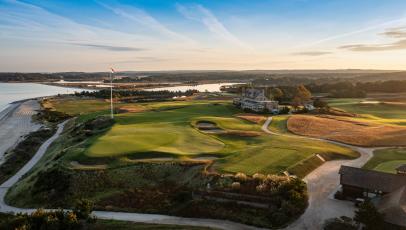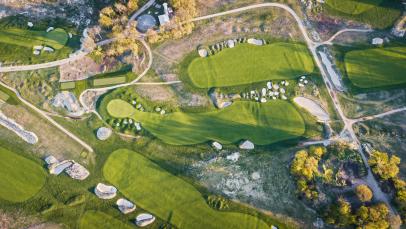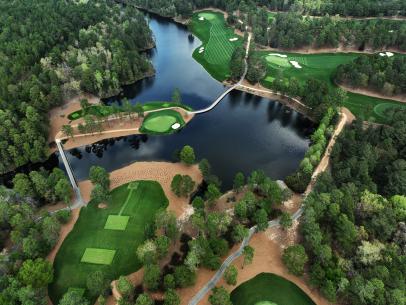There are few places in the world where cellphones are not permitted, but some of golf’s most exclusive clubs are chief among them. Most golf fans know that Augusta National Golf Club does not allow patrons attending the Masters to carry their phones, but you might not realize there are, in fact, a handful of hold-out country clubs that are strict about cellphone use.
Los Angeles Country Club, which will host the U.S. Open for the first time next week, is perhaps the sternest of the remaining anti-phone clubs. To those familiar with the club’s history, it makes sense: Consider that during the 1956 U.S. Amateur, the last championship held at LACC before the club opened its doors in 2017 for the Walker Cup, members of the club were repulsed when more than 3,000 anxious fans came to watch the finals.
As the late great Los Angeles Times columnist Jim Murray wrote then: “Horrified [were the members] when the public showed up in [ugh!] shorts and no shirts … and, in general, showed little respect for the musty old place, actually looking in the windows and disturbing the members dozing in front of their cribbage games.”
Here’s an in-depth and up-close preview of what the world of golf is about to see.
LACC isn’t alone among the strictest clubs when it comes to cellphone policies. Here are the clubs known for being the stingiest in terms of phone use:
Pine Valley Golf Club, Clementon, N.J.
Visiting the No. 1 golf course in the world is a treat. For anyone glued to their phone, however, it can be hard to completely unplug. But it’s a concession you must make visiting Pine Valley.
Red phone booths sit within the locker rooms at Pine Valley for anyone needing to make a call. The club has loosened its restrictions in terms of snapping photos with your phone on the course, as evidenced by some of golf’s social-media influencers sharing their experiences on the course. Otherwise, in the clubhouse, you won’t see a mobile device.
Chicago Golf Club, Wheaton, Ill.
Guests fortunate to receive an invite to one of the world’s most exclusive clubs know they won’t get any photos on their phone to prove they’ve played the course. You might snap a photo of the nondescript Chicago Golf Club sign as you enter the property, but that’ll be the last photo of the day. Only approved photographers are allowed to capture this Golden Age Seth Raynor design. You may use your phone in your car, but that’s it.
Seminole Golf Club, Juno Beach, Fla.
Golf’s biggest movers and shakers, such as Jimmy Dunne and Ed Herlihy, who helped organize the PIF/PGA Tour agreement, can be found sitting in the grill room at Seminole Golf Club, which is perhaps golf’s best hang. The no-phone policy allows everyone to speak freely, in case, you know, you’re discussing some intensely private details.
San Francisco Golf Club
One of golf’s most intense no-social-media policies can be found at San Francisco Golf Club. Golf Digest has removed panelists from its panel when they were found to be breaking this rule. The club isn’t messing around: As another panelist recalled, his caddie told him that members of the grounds crew are paid bonuses to rat out guests who have their phones out. That’s intense.
Augusta (Ga.) National Golf Club
Like we said, the no-phone rule for Masters patrons is well-known; besides getting pat down, nobody dares to try to sneak their phone in—in case big brother is watching.. If you’re one of the lucky few to receive an invitation from a member to play, however, the rules are more lax. Folks report that they were allowed to have their phones on the course, snapping all the photos they’d like on golf’s most famous property. As one panelist recounted: “My host allowed us and encouraged us to use our phones to take photos of the course and the outside areas. Just no photos were allowed in the clubhouse. And of course, no photos allowed on social media.”
Alotian Club, Roland, Ark.
Arkansas’ No. 1-ranked course was founded by Warren Stephens, son of former Augusta National chairman Jack Stephens, and in a lot of ways his club is modeled after Augusta. The strict cellphone policy is one such example. A mutual friend reports that his bag was searched by club officials after arriving on property.
Merion Golf Club, Ardmore, Pa.
The old-line Philly club hasn’t loosened its restrictions on phone use. In fact, in the past year or so, a number of panelists have reported that the rules are as strict as ever. “I got yelled at for taking my phone out to check a text on the range,” one panelist reports. Another: “My member was adamant that I couldn’t even have my phone in my bag over at the West course.”
Shoreacres, Lake Bluff, Ill.
Chicago Golf Club isn’t the only Chicago-area club with tight rules. Staff members arrive at your car after pulling up to the club—to take your golf clubs and show you around—but also to politely remind you that your phone is to stay in the car. Some have reported having their phone on them, with one spot being permitted by caddies to take photos: The area in front of the tee box on the club’s signature hole, the short par-3 12th.
Burning Tree, Bethesda, Md.
Just like Seminole, hanging out at Burning Tree provides the ability to rub elbows with some of the most important golfers in the world. Congressmen and former presidents are among those who frequent the ultra-exclusive Washington, D.C.-area club. When retiring to the grillroom after a round to sit at one of club’s long row tables, you won’t find many eyes looking at their phones—despite important emails and calls waiting for them.
Austin Golf Club
Similar rules to Chicago Golf Club apply to Austin Golf Club. Phones are only permitted in the parking lot. One panelist told a funny story about why he was convinced to follow this rule: “I thought it was a joke, and then when I pulled in, I saw Ben Crenshaw pacing the parking lot on his phone. I remember thinking "Well if that guy is going to follow the rules, I guess I need to!"
Garden City (N.Y.) Golf Club
One of America's few remaining all-men’s clubs is strict with some rules, and very loose about others, i.e.: You’re allowed to play with no shirt on if you want to, but you must wear a blazer in the clubhouse. The strict rules apply to cellphone use, too. One guest recalls taking his phone out to snap a picture of his locker for the day, upon which his member quickly responded: “If you need to use your phone, there’s a phone booth outside the locker room.” This is the same club where women are allowed inside the gates of the club for one day a year: to buy Christmas gifts for their husbands.
Friars Head Golf Club, Riverhead, N.Y.
Just like Garden City, Friars Head is ultra-strict on some rules. It seems like taking photos are OK—one panelist reported that his caddie used his phone to snap a bunch of photos, then texted the photos to him. Another panelist said he and his group used their cellphones freely in the locker room and when they were grabbing a drink after the round, but it was known nothing could go on social media. Another frequent visitor said Friars Head was among the most strict clubs he has seen.
As we learned with this project, it often depends what company you’re with—and how discrete you can be. You shouldn’t expect anyone to be cool with you chatting on the phone walking through the clubhouse of Shinnecock Hills or National Golf Links just as much as it wouldn’t be cool at your local club. Common sense usually prevails … though as you can see, there are definitely still sticklers.

• • •
Explore Golf Digest's recently relaunched Places to Play community, where you can add star ratings and reviews for all the courses you play. We've collected tens of thousands of reviews from our course-ranking panelists to deliver a premium experience, which includes experts' opinions, bonus course photography and videos, plus much more. Check it out here!





